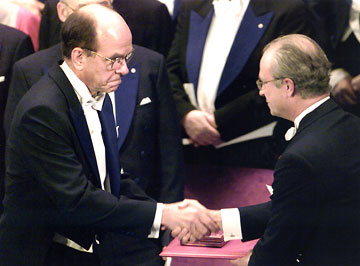 |
| K. Barry Sharpless, left, receives
the Nobel Prize for Chemistry from Swedish king Carl XVI
Gustav during the award ceremony at the concert hall in
Stockholm, Sweden, on Monday, December 10, 2001. AP/WIDE
WORLD PHOTOS |
Year in Review
By Mika Ono
When we look back at 2001, we will no doubt remember national
events—the devastating attacks of September 11 and the
country's war on terrorism. But the local news was not all
bleak. In fact, The Scripps Research Institute (TSRI) provided
much to celebrate.
This week, K. Barry Sharpless, W.M. Keck Professor at TSRI's
Skaggs Institute for Chemical Biology, was in Stockholm to
receive the Nobel Prize in Chemistry from the King of Sweden
Carl XVI Gustaf in a ceremony with much pageantry. Winning
the prize with two other chemists for work on the development
of catalytic asymmetric synthesis, Sharpless became the second
Nobel laureate on campus with Gerald Edelman, chair of the
Department of Neurobiology.
Based on the exemplary work of its researchers, TSRI was
ranked the most influential institution in the world in the
physical sciences (which includes the fields of chemistry
and physics), tenth in the medical sciences, and eleventh
in the biological sciences by the Institute for Scientific
Information. Examples of groundbreaking research from TSRI
labs this year are numerous:
- TSRI investigator Geoffrey Chang published an x-ray crystal
structure that provides the first detailed glimpse of a
membrane transporter protein, a finding that could be useful
for improving cancer therapy and fighting antibiotic-resistant
bacteria.
- Investigators Erica Ollmann Saphire, Dennis Burton, and
Ian Wilson were among the researchers who published the
structure of an antibody that effectively neutralizes human
immunodeficiency virus (HIV), a necessary first step in
the development of an effective vaccine.
- Investigators Dennis Burton and Anthony Williamson published
work that describes an antibody that arrests prion infections
in cell culture, a finding that may lead to a treatment
for mad cow disease.
- Investigators Peter Schultz and Paul Schimmel published
two separate papers in which they were the first to describe
methods of engineering bacterial cells to encode "unnatural"
proteins, which incorporate novel amino acids not found
in nature.
- Professor M. Reza Ghadiri and colleagues published a
paper that described a dramatically new approach for designing
drugs to combat such problems as infections with antibiotic-resistant
bacteria.
- Investigator Kim Janda designed a new vaccine against
cocaine that could become a valuable tool in treating addiction.
This and other research was made possible by the generous
support of individual donors, private foundations, and the
National Institutes of Health (NIH). Notable new awards from
the NIH this year included grants to a consortium of alcohol
researchers led by TSRI Professor George Koob, a Consortium
for Functional Glycomics at TSRI led by Professor James Paulson,
and a new Core Center for Vision Research at TSRI led by Associate
Professor Martin Friedlander. In addition, a gift from Helen
L. Dorris made possible the new Helen L. Dorris Institute
for the Study of Neurological and Psychiatric Disorders of
Children and Adolescents.
The face of the campus changed in 2001. A 54,000-square-foot
building, The Institute for Childhood and Neglected Diseases,
opened its doors on the east side of campus. The world's most
powerful NMR magnet was delivered to TSRI in June. And a new
sculpture by TSRI Trustee John Safer, "The Flame of Knowledge,"
was dedicated in memory of Norton Gilula, the first dean of
the graduate program and chair of the Department of Cell Biology.
Throughout the year, TSRI continued to fulfill its mission
as an educational institution. In May, 21 students graduated
from TSRI's two Ph.D. programs—both of which are currently
ranked in the top ten in the nation by U.S. News & World Report.
In August, 37 new students entered the programs.
TSRI's Science Outreach Program, which was presented with
an Exemplary Partnership Award from the San Diego City Schools
in June, continued to promote science education in the community
through seminars and internship programs for teachers and
middle-school, high-school, and undergraduate students. The
program received major gifts this year from Chair of the TSRI
Board of Trustees John Diekman and his wife Susan, and The
William Randolph Hearst Foundation.
Indeed, TSRI provided much welcome news in 2001.

|
|

